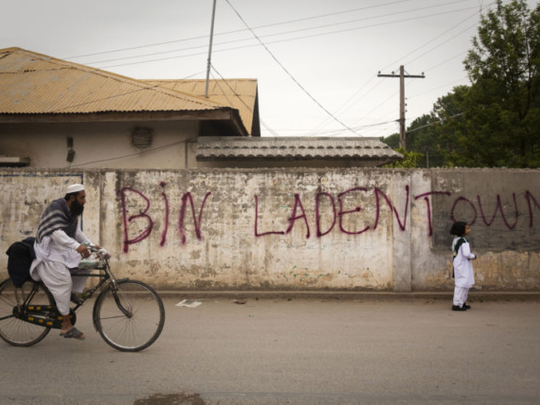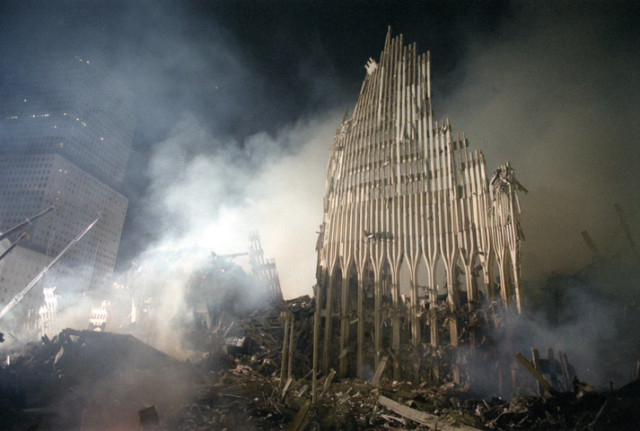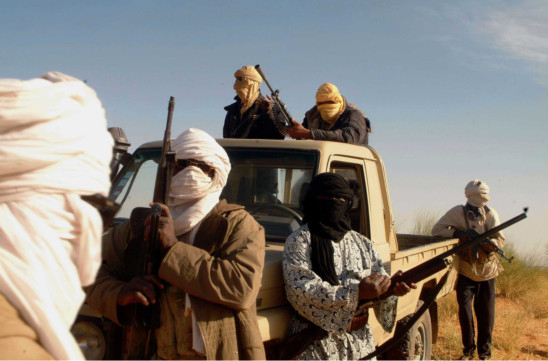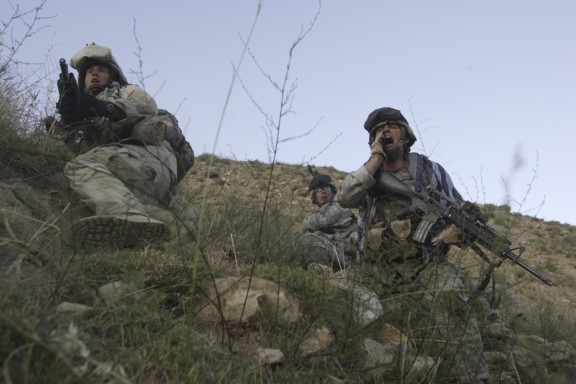
When Osama bin Laden was killed in May 2011, a long, bloody and controversial battle seemed to be drawing to a close. The Al Qaida network was turning into a shadow of its former self. Anwar al Awlaki, a senior militant leader in Yemen, was also killed soon after in a US drone strike, and others leaders perished in the tribal areas of Pakistan.
Yet today, the threat from extremists appears once again to be on the rise, though it has taken a more nebulous, multifarious face. Militants in Pakistan continue to be a big concern, not least for the UK, which sees tens of thousands of British nationals travelling to and from Pakistan every year. But other movements too have been hitting the headlines.
In north Africa, Al Qaida in the Islamic Maghreb (AQIM) has taken control of large swaths of Mali and prompted a dramatic French military intervention. In Syria, western governments are increasingly anxious about the rise of Jabhat Al Nusra, a extremist group that is proving the most disciplined and tenacious threat to the regime of Bashar Al Assad.
In Yemen, the ability of the Al Qaida in the Arabian Peninsula (AQAP) to strike the west remains a serious concern for counter-terrorism officials, given its proven ability to mount attacks on aircraft bound for the US.
Meanwhile, in Somalia and northern Nigeria, the groups Al Shabaab and Boko Haram are raising concern with campaigns to kidnap foreign nationals and detonate bombs.
“Back in 2011, people may have thought that we had dealt a decisive blow to jihadism with the death of Bin Laden. But today, the picture suddenly looks complex,” says a senior western counter-terrorism official. “Some theatres of activity are getting squeezed, others are growing. The threat now seems more divergent.”
Some leaders view all these self-described allies of Al Qaida in sweeping terms. After the dramatic hostage crisis in Algeria last month, which left at least 37 foreign workers dead, Britain’s Prime Minister David Cameron spoke of an “existential” and “global” threat that will take “decades, rather than months” to overcome.
Overdone rhetoric
Others, however, argue that such rhetoric is overdone. They suggest that the links between different franchises are often tenuous, if they exist at all, and many of the groups have emerged from principally regional struggles, sharing a similar extremist ideology and using the Al Qaida label to galvanise their message.
Officials are comforted by the fact that over the past year a series of big events — such as the London Olympics — have taken place in western capitals without incident. But they still fear the potential and growth of Al Qaida franchises, and their ability to contain them.
In the Middle East, popular uprisings in Egypt, Libya and Tunisia have shown how marginal extremists were in their societies. But they have also produced new governments with a limited ability to assert control over their territory. In Libya, for example, the fall of the Gaddafi regime has left the country in the hands of competing militias. In Tunisia and Egypt, extremists who had been released from prison could attempt to regroup.
Above all the number of ungoverned spaces — in Mali, Yemen, Somalia and the Pakistani tribal areas - has expanded. Security experts argue that while the threat from Bin Laden’s core group in Pakistan may have dwindled, western intelligence agencies are under pressure to keep up with this changing kaleidoscope of regional franchises.
“When Al Qaida was largely holed up in the badlands of Pakistan and the tribal areas, the US had the capability to deal with them in a much more focused way through drone attacks,” says Nigel Inkster, a former UK intelligence official now at the London-based International Institute for Strategic Studies. “But now we have a far more disaggregated threat that no one country has the capability to tackle. It makes dealing with these extremist groups — and knowing when and how to intervene — a great deal more difficult.”
Immediate risks
As they survey this evolving scene, security officials in the US and Europe focus on immediate risks their nationals face at home and abroad. Four issues top their list of concerns.
First, despite the heavy media focus on events in north Africa, it is still the capability of Yemeni-based AQAP that worries most, despite three years of US drone strikes.
The organisation, created through a merger of Saudi and Yemeni extremist groups, has tried several times in the past three years to carry out bomb attacks in the west using complex explosives that are difficult for airline scanners to detect.
“AQAP still represents a very serious threat to western interests, having shown the motivation and the will to carry out attacks as well as the capability to put together a bomb,” says Gregory Johnsen, an authority on AQAP. “Nothing in my research suggests that they have become a lesser threat than three years ago.”
The number of extremists associated with AQAP has swelled, he says, from about 300 fighters in 2009 to well over 1,000 today, if not several thousands.
The second immediate concern is that European nationals committed to extremism are travelling to Syria to fight alongside Jabhat Al Nusra.
The group brings together extremist fighters with considerable expertise in bomb making. But Syria is also far easier for westerners to access than other extremist theatres, such as Yemen or Mali.
“There is not an immediate risk of these people conducting a bomb attack in a major capital,” says a western analyst. “But if security services don’t interrupt this traffic of individuals right now, they may face attacks on their territory in a few years’ time.”
The third risk is that France’s intervention in Mali could trigger reprisals by extremist groups inside France. Intelligence experts believe AQIM does not yet have the means to direct an attack on France or other European states from its hide-outs in north Africa. But they fear that the French operation could help AQIM mobilise hitherto passive supporters living in France and with strong links to the Sahel.
A fourth worry is that while AQIM may have limited capability to hit Europe directly, the seizure of the In Amenaas gas facility demonstrated the ability of extremists to attack large businesses and industrial sites in the Middle East and north Africa.
Yet it is also a movement with weaknesses and might have over-reached in its attempt to take over much of Mali. It has also been undermined by internal divisions. Mokhtar Belmokhtar, who led the Algerian hostage operation, split from Abdul Malek Droukdel late last year following a leadership struggle.
“By leaving Belmokhtar alone you could create a self-destructive dynamic within AQIM,” suggests Norman Benoman, a former Libyan extremist now at the Quilliam Foundation.
Syrian crisis
Containing Syria’s Jabhat Al Nusra would require a different approach. With an estimated 7,000 core fighters, it is proving to be far more disciplined than the militants of the Free Syrian Army. It is not only fighting Bashar Al Assad’s forces effectively but also playing a “welfare” role in distributing aid, taking over the distribution of breakfast in Aleppo, for example.
The US has expressed its concern over the Al Nusra brigade’s growth by formally proscribing the group. But in Europe, officials say that marginalising Al Nusra could be achieved by bolstering the more moderate rebel forces, an effort that has been complicated by the reluctance for direct military assistance to the opposition.
AQAP has learnt to adapt to the changing environment. Afraid of being sidelined by the uprising that forced the departure of Ali Abdullah Saleh, the long-time Yemen president, AQAP sought to rebrand itself last year by creating a new affiliate called Ansar Al Sharia. It was charged with providing social services in the Arab world’s most impoverished country. Although it has been driven out of the southern areas it had taken over last year, the extremist group continues to recruit.
Johnsen, author of The Last Refuge: Yemen, Al Qaida, and America’s War in Arabia, says the perception of civilian casualties inflicted by drone strikes has contributed to the group’s ability to grow and attract tribal support.
Western officials insist that the more complex threat posed by extremists today should not overshadow what has been achieved.
“If Bin Laden were alive today he would look back over the decade since 9/11 and be sorely disappointed by how little his movement has achieved,” says one. “The huge investment by a number of governments in their intelligence services since the September 11 attacks on America has meant that many plots have been foiled. And his movement has been totally sidelined by the Arab Spring.”
But officials say that what is most worrying about the extremist franchises is their ability to adapt to changing circumstances.
In 2008, Lashkar e-Taiba operatives killed 166 people in an organised attack in Mumbai. In the last few weeks, Belmokhtar in Algeria shocked most western governments with the scale of the operation at In Amenas.
“In my business there is a lot that is changing,” says a counter-terrorism official. “But one thing that stays the same is the ability of these groups to learn, to innovate and to suddenly surprise us.”
— Financial Times
















